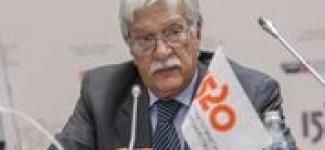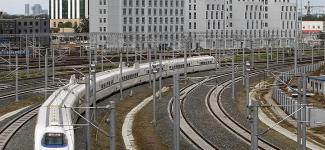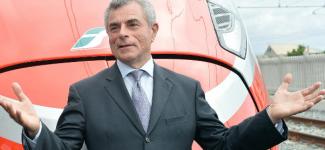Home › Projects › White Book › Intermobility Strategy for the METR Region
Intermobility Strategy for the METR Region

The countries forming the METR region represent a reality of great importance all around the world in terms of economic issues, political and social matters, and culture and science.
The key components for a better merging of economies of the involved countries are their commercial interconnections and, therefore, an efficient and functional transport network for the subsequent transfer of goods.
Considering their geographic location and the extent of the territories concerned, every transport mode is involved in interchange processes. Road, train, ship, airplane: Each of them with its specific characteristics and roles can improve the system and lead to an intense and profitable interconnection among countries and economies seemingly defined by different features.
In this presentation, the topic of intermodal transport of goods will be outlined by its specific areas: road-rail; road-sea; and road-rail-sea, especially for container sea traffic.
The goal is to draw a picture of the current realities and consequently to elaborate some suggestions for a larger development of intermodality in interchanges, with the aim of a fluent, simple and easier interconnection among the economies of the METR countries.
A close examination of the current situation of transport of goods in the METR region allows us to detect the currently predominant methodologies and to consider where and how intermodality can, along with infrastructural interventions, help evolve their economies in a positive way.
Intermodal transport techniques
Combined road-rail transport (CRRT)
It is the most modern and efficient inland transport solution in alternative to the full road one. This technique uses Intermodal Loading Units (ILU), designed to be loaded on rail cars as semi-trailers with grappler pockets and swap bodies. (To note, swap bodies are equivalent to a loading body of an articulated truck or semi-trailer and are placed on a train car in rail journeys and on a trailer or articulated truck in road transportation).
Transport is basically formed by three routes: a first short route from the loading point to the local intermodal terminal; a long-distance rail route usually with complete trains from terminal to terminal; and a final short road route to the downloading point.
This technique was born in the United States in the mid-1950s and is still the main type of transport there. A decade later, Europe also developed its first combined transport techniques. During the course of 50years, CRRT experienced important changes, especially in certain European countries like Germany, Switzerland, Belgium, Austria and Italy.
An important relationship network connecting European countries is currently in place. This is particularly important for Italy because about 70 percent of exports are directed toward northern European countries across the Alps, and in some cases they also cross third countries. In this context this system has advantages compared with traditional rail or road transport. As a matter of fact, railway brings the best of its functionality with CRRT.
Below are European reference data from the UIRR (International Union for Road-Rail), an organization composed of 14companies that together manage up to 50percent of traffic. These data are for 2013:
| Traffic type | ILU | TEU |
|---|---|---|
| National | 924.294 | 1.848.588 |
| International | 1.701.999 | 3.403.998 |
These numbers prove the efficiency and penetration of the system even in time of economic crisis for many European countries, which obviously affects the volume of goods being transported.
Combined road-sea transport (CRST)
A CRST, also called a sea motorway, represents an important modal alternative, especially for business across the Mediterranean Sea. Thanks to modern ferry boats, it allows the massive transportation of semi-trailers (RoRo technique) and, once the hold is full, of containers as well. This is for international traffic — links among the Italian peninsula and the islands of Sicily and Sardinia are typical — and for connections between the northern and southern coasts of the Mediterranean Sea, as well as for East-West connections.
In the case of Italy, for instance, national routes between northern ports and the islands, as well as international routes between northern ports and Spanish ports, are clear examples of cost savings and time savings thanks to a substantial reduction of the covered distance and easiest connections.
Nowadays, the majority of RoRo ferries are big and efficient ships suitable for the transportation of passengers and cargo vehicles. They have proven an essential means of transportation that has made easier much of the business between Europe and the so-called Maghreb countries on the Mediterranean coast of northern Africa.
Intermodal transport of maritime containers
Maritime containers represent the biggest invention of the last 60years in the transport of goods worldwide. With their evolution and gradual global expansion, they basically replaced all other means of maritime transport of various goods and allowed for market globalization.
Container ships have now increased their dimensions, reaching the load capacity of 22.000Teu. With the increased load capacity, the opportunity to decrease the number of port of calls arose, concentrating the handling of containers directed to other ports of final destination called “regional” ports (this is “transhipment”handling). Transport — including transport by sea — between the port of call of the biggest ship (“mother ship”) and the regional port of final destination of the container is carried out by limited capacity ships (“feeder ships”).
Important issues in the intermodal chain of maritime containers — once the ship arrives at the destination port — are the time of leaving the port and the ease with which goods can reach the final delivery destination.
This last inland leg can be made both by road and through an intermodality system similar to the CRRT, with a first rail leg from the port to an inland terminal and from there by road to final destination. The use of railway becomes more and more fundamental and necessary with port traffic growth, thanks to the use of complete point-to-point trains. In major ports, such as Rotterdam, container traffic handled by rail can reach up to 50percent. Obviously, in order to reach those levels, the whole port rail system must be adjusted to the traffic system as well as to the connecting railway network. (In Rotterdam a dedicated railway line was built, the Betuweroute, only for container traffic that links the port to the German railway network.)
Naval gigantism is a parallelism of port gigantism. In the worldwide chart of the major container ports (more than 7million Teu per year), there are only three European ports, all of them from the NorthernRange (Rotterdam, Hamburg and Antwerp). Eastern ports lead the chart, with peaks beyond 32million Teu per year.
Intermodality in METR countries
What has been described above about intermodal techniques shows that these transport systems can significantly contribute to the development of interchanges among the METR countries, expanding their interconnections and increasing their presence in the globalized economy.
At the moment intermodality is experiencing deep differences among various METR countries. For this reason, we will make a closer examination of each different reality with the aim of understanding the situation and make some suggestions for future evolutions.
The EU countries
The EU countries, especially northern ones, have already developed intermodality considerably. It is not by chance that European ports with the highest container traffic are in Holland, Germany, and Belgium. CRRT is also experiencing a remarkable application in Germany, Belgium, Holland, Austria and in northern Italy. In Italy, freight terminals began to be designed in the 1960s, and their construction started in the 1980s.
Freight terminals are multifunctional logistic structures of great value, and their functional concept could be useful in the METR region to develop and ease the traffic of goods. A freight terminal is designed mainly for logistics, with an annexed intermodal terminal. Besides traffic concentration, in the case of intermodality, freight terminals allow considerable cost and time reduction in road traffic.
Germany, for instance, already has adopted the freight terminal and in some cases has realized very big logistics intermodality in its cities. An outstanding example is Duisburg, where there are three means of transport: road, rail and internal navigation connected with ports.
The EU countries have defined nine strategic corridors, together forming the TEN-T, which by 2020 will update and improve the big European routes for passengers and goods. They are a remarkable opportunity for connection not only for interchanges among EU countries, but also with Russia, Ukraine, Belarus and Mediterranean countries.
Russia
Given its dimensions and economic reality, Russia is without any doubt a priority partner for the other METR countries, as well as for the southern Mediterranean coast countries. Russia has a wide and well-equipped railway network, its most impressive characteristic being the line from Moscow to Vladivostok. Russian Railways is one of the most important railway systems in the world.
The two significant limitations of the Russian railway network related to integration with other networks are the gauge difference and, specific to intermodality, the current transport limit of 20’ and 40’ containers, excluding the other ILU — swap bodies and semi-trailers — due to the lack of suitable train cars and terminal structures.
These limitations have a strong influence on the development of intermodal relationships between Europe and Russia. Problems arising from different railway gauges could be overcome by developing CRRT with the option of transporting swap bodies and semi-trailers that could be transferred at the border between train cars with different gauges. The use of swap bodies and semi-trailers with EC measures allows the use of EUR-pallet, which in the ISO measures of maritime containers doesn’t allow the complete use of the ILU loading surface.
Interesting experiments in railway connections between Europe, China and Korea via the Trans-Siberian rail line are currently being studied as an alternative to the classic maritime transport between Chinese and European ports. The advantage of rail could lead to a remarkable reduction in transit time, which is particularly useful for Chinese and Korean production centers far from the sea. These initiatives are very likely to become more and more widespread and will considerably foster certain types of traffic particularly suitable to intermodal railway transport. In this context the possible role of Russian railway seems clear.
Given the breadth of Russia’s territory, a specific study could be conducted to evaluate the benefits of structures similar to Italian freight terminals located near major cities and major industrial centers, in order to promote interchange systems with a greater use of railway.
Turkey
Turkey is one the most dynamic and advanced Mediterranean countries. Its interchanges with European countries, especially Germany, have considerably increased in the last decade. Until the 1980s, the interchange of goods was made completely by road through the former Yugoslavia. Given the wars in that area in the 1990s, Turkey was forced to change its transport routes. It initially passed through the Greek port of Igoumenitsa that is connected by ferry with Italian Adriatic ports, and, more recently, it studied more extreme systems for the transport of goods.
This was the genesis of the first maritime interconnections organized and supported by Turkish road transport unions with ferries on the routes from Turkish ports to Trieste and vice versa. At the beginning, in the vast majority of cases Turkish sponsors used this service in order to continue to travel by road from Trieste to the final destination.
Later, the first variation of rail connection was implemented by Austria with a Trieste-Salzburg rolling motorway capable of transporting the entire vehicle and its driver inside the train. Afterward, with remarkable skill, Turkish enterprises successfully created a large fleet of vehicles and, therefore, changed the organization design. At the moment in Trieste, ferries of different companies arrive and leave with many voyages daily and semi-trailers are mainly moved on special trains having as departure/destination Bettembourg in Luxembourg; Cologne, Duisburg, Frankfurt, Ludwigshafen and Munich in Germany; and Ostrava in the Czech Republic.
Turkish operator initiatives show how intermodality can help develop interconnections between countries far from each other. However, inside Turkey the vast majority of transport is carried out by road, even though the country’s size would justify the study of intermodal alternatives. It is likely that in the future the dynamism of Turkish management could seriously take into account this option.
The Middle Eastern countries
Particular attention should be paid to the Middle Eastern countries. Unfortunately this region is characterized by wars and conflicts that deeply damage normal economic activities and, consequently, interchanges with the rest of the world. For example, the situation is dramatic in Syria, with consequences in Lebanon and Jordan. The only exception is Israel, which in spite of the tragic conflict in the Gaza Strip in Palestine has considerable interchanges with Europe.
Logically, the vast majority of potential interchanges toward northern Mediterranean coast countries can be made by sea with containers, as well as rolling stocks loaded on RoRo vessels. It is therefore necessary that these countries, particularly the ones devastated by war, are equipped as soon as possible with highly effective structures and organizations suitable for loading and unloading vessels.
Some considerations for actions and interventions
Creation of a master plan for METR traffic relations network
Taking into account arrangements made in the European Union with the creation of the nine TEN-T corridors with the aim of improving the flow of interchanges using intermodal techniques at the utmost, it could be interesting to carry out a study to identify the major traffic flows between METR countries.
The study could do the following: check the current situation of road, rail and port infrastructures; verify whether the existing system is able to meet medium-term traffic needs; identify adjustments in organization, rules, customs, etc. in order to improve the traffic of goods; and highlight the need of infrastructure interventions — for example, an interest in building a network of freight terminals — in relation to possible development of medium-term traffic flows.
This study could be divided into multiple phases, involving interested countries, as well as the cluster of transport and logistics involved. On one hand, it could identify the needs and resources to be allocated to these projects in order to evaluate their feasibility. On the other hand, it could analyze the returns expected in the short, medium and long term from a policy mainly based on the development of interchanges, in order to better balance reference conditions among METR counties.
Activation of a policy of higher intermodal integration among METR countries
Coordination and balance are the conditions necessary for developing intermodality among METR countries. Until now, different countries have developed useful initiatives and connections for the transport of goods among themselves. However, in order to expand intermodality to areas where it is still absent, an agreement among countries is needed, and the abovementioned master plan could be considered as its basic document.
An organization could be created in partnership with business representatives and with the ministries of commerce and transport of the countries involved. Its aim would be to identify near- and medium-term needs and define intervention guidelines, as well as to create an implementation plan, perhaps even involving the European Commission, in order to reach the expected results in the long term.
Infrastructural and operational aspects of intermodality in METR countries
Intermodality development should include suitable lines and nodal infrastructures, that is, ports and inland terminals. For example, for railway lines and terminals, the EU has said that for the purpose of intermodality, EU railways should adapt their infrastructure to the standard train performance, meaning a length of 750meters, a weight on hook of 2,000tons and a maximum shape of P400.
If length and weight influence management, then an unadapted shape can obstruct CRRT with semi-trailers, while it is a less substantial problem for swap bodies (using car trains with low loading platforms) and containers according to heights.
Inland transport over time has improved in road transport (roads and tunnels), as well as in rail transport (base tunnels, underwater tunnels, shape and gauge adjustments). For a country like Italy, the new Gotthard line and the Brenner Base Tunnel are important strategic factors for smooth traffic of goods. In the same way, the Channel Tunnel and the fixed link between Denmark and Sweden are important for other European areas. Examples of important strategic factors for ports are the UIC gauge in the line between Barcelona and the French network, the Betuweroute line for Rotterdam, and the Third Passage for Genoa.
Interchange between METR countries and Maghreb countries
The Maghreb countries — the Mediterranean coast of Northern Africa — deserve particular attention, since after the Arab Spring, the most important countries in this area have shown great interest in re-launching their economies and increasing interchanges with European countries. Egypt, Tunisia, Algeria and Morocco are the most visible examples of this change. Of course, this interest has to be supported by transport and logistics organizations capable of meeting the needs existing on the other Mediterranean coasts.
As Maghreb countries become more frequent sub-suppliers in European industry, the maritime connection system with RoRo ferries used for rolling stock and container transport already existing in some of those countries should increase accordingly. Inland transport in Maghreb is made at the moment by road, since there are no requirements to organize an intermodal railway system that could meet the market’s needs. Therefore, it is essential to have a road network that could reach industrial centers and major urban areas where there are more consumers.
In this context it also could be interesting to consider the possibility of realizing ad hoc logistic infrastructuresthat allow the reduction of the costs of collecting and distributing goods.
Sign up for MIR initiative email updates
Sign up to receive monthly notifications about new arctiles published and other events on your email.
Other articles
 Eugenio Muzio
Eugenio Muzio
Eurasian High-Speed Metro for Freight Transportation
 Luis Castilla
Luis Castilla
Innovation for Sustainable Mobility Development in the METR Region
 Piero Fassino
Piero Fassino
Eurasian Metro
 Zhu Ying
Zhu Ying
High speed railway’s impact on China
 Mauro Moretti
Mauro Moretti
METR region transport systems
 Aleksandr Misharin
Aleksandr Misharin
